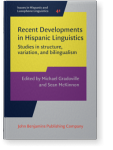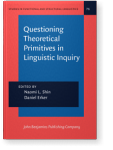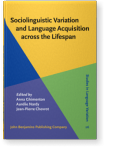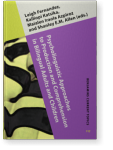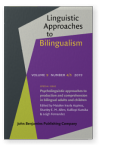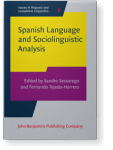Naomi Shin
List of John Benjamins publications for which Naomi Shin plays a role.
Journal
Book series
Title
Questioning Theoretical Primitives in Linguistic Inquiry: Papers in honor of Ricardo Otheguy
Edited by Naomi Shin and Daniel Erker
[Studies in Functional and Structural Linguistics, 76] 2018. vi, 293 pp.
Subjects Syntax | Theoretical linguistics
2024 Chapter 2. Monolingual and bilingual child language acquisition and language change Lifespan Acquisition and Language Change: Historical sociolinguistic perspectives, Sanz-Sánchez, Israel (ed.), pp. 44–63 | Chapter
This chapter reviews research on children’s monolingual and bilingual acquisition of linguistic variation to consider children’s role in language change. Many patterns of variation are learned early and veridically, but some are acquired late and may be more susceptible to change. Further,… read more
2021 Chapter 4. Testing interface and frequency hypotheses: Bilingual children’s acquisition of Spanish subject pronoun expression Sociolinguistic Variation and Language Acquisition across the Lifespan, Ghimenton, Anna, Aurélie Nardy and Jean-Pierre Chevrot (eds.), pp. 81–102 | Chapter
The Interface Hypothesis predicts that syntax-discourse interface features are acquired later than features involving the interface between syntax and other components of grammar. The Frequency Hypothesis predicts that frequent grammatical patterns are acquired earlier than infrequent ones. This… read more
2021 Child heritage speakers’ production and comprehension of direct object clitic gender in Spanish Psycholinguistic Approaches to Production and Comprehension in Bilingual Adults and Children, Fernandez, Leigh B., Kalliopi Katsika, Maialen Iraola Azpiroz and Shanley E.M. Allen (eds.), pp. 159–186 | Chapter
This study investigates 37 child heritage speakers’ direct object (DO) clitics in Spanish. Results from a production task show that DO expression versus omission was related to Spanish vocabulary: the lower the vocabulary score, the more omitted DOs. In contrast, DO clitic gender was related to… read more
2019 Child heritage speakers’ production and comprehension of direct object clitic gender in Spanish Psycholinguistic approaches to production and comprehension in bilingual adults and children, Azpiroz, Maialen Iraola, Shanley E.M. Allen, Kalliopi Katsika and Leigh B. Fernandez (eds.), pp. 659–686 | Article
This study investigates 37 child heritage speakers’ direct object (DO) clitics in Spanish. Results from a production task show that DO expression versus omission was related to Spanish vocabulary: the lower the vocabulary score, the more omitted DOs. In contrast, DO clitic gender was related to… read more
2018 First principles in linguistic inquiry Questioning Theoretical Primitives in Linguistic Inquiry: Papers in honor of Ricardo Otheguy, Shin, Naomi and Daniel Erker (eds.), pp. 1–6 | Chapter
2016 Children’s Spanish subject pronoun expression: A developmental change in tú? Spanish Language and Sociolinguistic Analysis, Sessarego, Sandro and Fernando Tejedo-Herrero (eds.), pp. 157–176 | Article
This study explores children’s acquisition of structured morphosyntactic variation by examining Spanish subject pronoun expression. Analyses of 5,923 verbs produced by 154 Mexican children, ages 6 to 16, show that the variables that most strongly constrain the oldest children’s pronoun usage –… read more
2016 Maintenance of Spanish subject pronoun expression patterns among bilingual children of farmworkers in Washington/Montana Spanish in Context 13:2, pp. 173–194 | Article
It has been suggested that contact between Spanish and English results in an increased rate of Spanish subject pronouns and a desensitization to factors that constrain pronoun usage. Yet, evidence for such contact-induced change has been found in some U.S. communities, but not others. In this study… read more
2016 “Fijáte…sabes que le digo yo”: Salvadoran voseo and tuteo in Oregon* Forms of Address in the Spanish of the Americas, Moyna, María Irene and Susana Rivera-Mills (eds.), pp. 305–324 | Article
This study investigates voseo and tuteo among Salvadorans residing in Oregon and examines whether tuteo increases as a result of contact with Hispanics of Mexican descent. Analyses of 404 tokens of 2sg verbs taken from natural conversations indicated clear preferences depending on social networks.… read more
2011 Las keys versus el key: Feminine gender assignment in mixed-language texts Spanish in Context 8:1, pp. 119–143 | Article
Previous research on language mixing has revealed similarities in written and oral production with respect to syntactic and pragmatic patterns (e.g. Callahan 2004). In this study we find, however, that the two modes of expression diverge in loanword gender assignment. English-origin NPs inserted… read more
2005 Overt nonspecific Ellos in Spanish in New York Spanish in Context 2:2, pp. 157–174 | Article
In general Spanish, references to nonspecific third-person plurals are usually made by means of a verb occurring with the null form of the subject pronoun, as in llamaron del banco, rather than by means of a verb occurring with the overt form of the subject pronoun. In contrast to the position in… read more
2003
An adaptive approach to noun gender in New York contact Spanish
A Romance Perspective on Language Knowledge and Use: Selected papers from the 31st Linguistic Symposium on Romance Languages (LSRL), Chicago, 19–22 April 2001, Núñez-Cedeño, Rafael, Luis López and Richard Cameron (eds.), pp. 209–232 | Article
